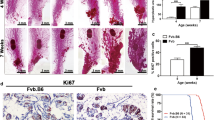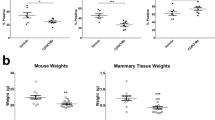Abstract
Tumors evade immune recognition and destruction in many ways including the creation of an immune-suppressive tumor microenvironment (TME). Dendritic cells (DC) that infiltrate the TME are tolerogenic, and suppress effector T cells and anti-tumor activity. Previous reports demonstrated that a key regulator of tolerance in DC is the transcription factor FOXO3. Gender disparity has been studied in cancer in relation to incidence, aggressiveness, and prognosis. Few studies have touched on the importance in relation to impact on the immune system. In the current study, we show that there are significant differences in tumor growth between males and females. Additionally, frequencies and the function of FOXO3 expressed by DC subsets that infiltrate tumors vary between genders. Our results show for the first time that DC FOXO3 expression and function is altered in females. In vitro results indicate that these differences may be the result of exposure to estrogen. These differences may be critical considerations for the enhancement of immunotherapy for cancer.






Similar content being viewed by others
Abbreviations
- AR:
-
Androgen receptor
- BMDC:
-
Bone marrow-derived DC
- ChIP:
-
Chromatin immunoprecipitation
- DHT:
-
Dihydrotestosterone
- E2:
-
17-β-estradiol,
- ERα:
-
Estrogen receptor alpha
- ERβ:
-
Estrogen receptor beta
- HCC:
-
Hepatocellular carcinoma
- Het:
-
Heterozygous
- MDSC:
-
Myeloid-derived suppressor cell(s)
- pDC:
-
Plasmacytoid DC
- TADC:
-
Tumor-associated dendritic cell(s)
- Tfm:
-
Testicular feminized mouse
- TME:
-
Tumor microenvironment,
- Treg:
-
T regulatory cell(s)
References
Cutolo M, Sulli A, Straub RH (2014) Estrogen’s effects in chronic autoimmune/inflammatory diseases and progression to cancer. Expert Rev Clin Immunol 10(1):31–39. doi:10.1586/1744666x.2014.863149
Hwang TL, Chen CY (2012) Gender different response to immunonutrition in liver cirrhosis with sepsis in rats. Nutrients 4(3):231–242. doi:10.3390/nu4030231
Klein SL, Marriott I, Fish EN (2015) Sex-based differences in immune function and responses to vaccination. Trans R Soc Trop Med Hyg 109(1):9–15. doi:10.1093/trstmh/tru167
Krementsov DN, Noubade R, Dragon JA, Otsu K, Rincon M, Teuscher C (2014) Sex-specific control of central nervous system autoimmunity by p38 mitogen-activated protein kinase signaling in myeloid cells. Ann Neurol 75(1):50–66. doi:10.1002/ana.24020
McCombe PA, Greer JM, Mackay IR (2009) Sexual dimorphism in autoimmune disease. Curr Mol Med 9(9):1058–1079
Nhamoyebonde S, Leslie A (2014) Biological differences between the sexes and susceptibility to tuberculosis. J Infect Dis 209(Suppl 3):S100–S106. doi:10.1093/infdis/jiu147
van Lunzen J, Altfeld M (2014) Sex differences in infectious diseases-common but neglected. J Infect Dis 209(Suppl 3):S79–S80. doi:10.1093/infdis/jiu159
Yeh SH, Chen PJ (2010) Gender disparity of hepatocellular carcinoma: the roles of sex hormones. Int Soc Cell 78(Suppl 1):172–179. doi:10.1159/000315247
Wichmann MW, Ayala A, Chaudry IH (1997) Male sex steroids are responsible for depressing macrophage immune function after trauma-hemorrhage. Am J Physiol 273(4 Pt 1):C1335–C1340
Gilliver SC, Ashworth JJ, Mills SJ, Hardman MJ, Ashcroft GS (2006) Androgens modulate the inflammatory response during acute wound healing. J Cell Sci 119 (Pt 4):722–732. doi:10.1242/jcs.02786
Olsen NJ, Olson G, Viselli SM, Gu X, Kovacs WJ (2001) Androgen receptors in thymic epithelium modulate thymus size and thymocyte development. Endocrinology 142(3):1278–1283. doi:10.1210/endo.142.3.8032
Roden AC, Moser MT, Tri SD, Mercader M, Kuntz SM, Dong H, Hurwitz AA, McKean DJ, Celis E, Leibovich BC, Allison JP, Kwon ED (2004) Augmentation of T cell levels and responses induced by androgen deprivation. J Immunol 173(10):6098–6108
Lai JJ, Lai KP, Zeng W, Chuang KH, Altuwaijri S, Chang C (2012) Androgen receptor influences on body defense system via modulation of innate and adaptive immune systems: lessons from conditional AR knockout mice. Am J Pathol 181(5):1504–1512. doi:10.1016/j.ajpath.2012.07.008
Sachdeva M, Mo YY (2010) Stroma-mediated expression of estrogen and its role in cancer. Front Biosci 15:237–248
Che Q, Liu BY, Liao Y, Zhang HJ, Yang TT, He YY, Xia YH, Lu W, He XY, Chen Z, Wang FY, Wan XP (2014) Activation of a positive feedback loop involving IL-6 and aromatase promotes intratumoral 17beta-estradiol biosynthesis in endometrial carcinoma microenvironment. Int J Cancer 135(2):282–294. doi:10.1002/ijc.28679
Suzuki T, Miki Y, Nakamura Y, Moriya T, Ito K, Ohuchi N, Sasano H (2005) Sex steroid-producing enzymes in human breast cancer. Endocr Relat Cancer 12(4):701–720. doi:10.1677/erc.1.00834
Chuang KH, Altuwaijri S, Li G, Lai JJ, Chu CY, Lai KP, Lin HY, Hsu JW, Keng P, Wu MC, Chang C (2009) Neutropenia with impaired host defense against microbial infection in mice lacking androgen receptor. J Exp Med 206(5):1181–1199. doi:10.1084/jem.20082521
Lai JJ, Lai KP, Chuang KH, Chang P, Yu IC, Lin WJ, Chang C (2009) Monocyte/macrophage androgen receptor suppresses cutaneous wound healing in mice by enhancing local TNF-alpha expression. J Clin Investig 119(12):3739–3751. doi:10.1172/JCI39335
Straub RH (2007) The complex role of estrogens in inflammation. Endocr Rev 28(5):521–574. doi:10.1210/er.2007-0001
Paharkova-Vatchkova V, Maldonado R, Kovats S (2004) Estrogen preferentially promotes the differentiation of CD11c + CD11b(intermediate) dendritic cells from bone marrow precursors. J Immunol 172(3):1426–1436
Papenfuss TL, Powell ND, McClain MA, Bedarf A, Singh A, Gienapp IE, Shawler T, Whitacre CC (2011) Estriol generates tolerogenic dendritic cells in vivo that protect against autoimmunity. J Immunol 186(6):3346–3355. doi:10.4049/jimmunol.1001322
Dejean AS, Beisner DR, Ch’en IL, Kerdiles YM, Babour A, Arden KC, Castrillon DH, DePinho RA, Hedrick SM (2009) Transcription factor Foxo3 controls the magnitude of T cell immune responses by modulating the function of dendritic cells. Nat Immunol 10(5):504–513. doi:10.1038/ni.1729
Thompson MG, Larson M, Vidrine A, Barrios K, Navarro F, Meyers K, Simms P, Prajapati K, Chitsike L, Hellman LM, Baker BM, Watkins SK (2015) FOXO3-NF-kappaB RelA protein complexes reduce proinflammatory cell signaling and function. J Immunol 195(12):5637–5647. doi:10.4049/jimmunol.1501758
Stauffer JK, Scarzello AJ, Andersen JB, De Kluyver RL, Back TC, Weiss JM, Thorgeirsson SS, Wiltrout RH (2011) Coactivation of AKT and beta-catenin in mice rapidly induces formation of lipogenic liver tumors. Cancer Res 71(7):2718–2727. doi:10.1158/0008-5472.can-10-2705
Salem ML (2004) Estrogen, a double-edged sword: modulation of TH1- and TH2-mediated inflammations by differential regulation of TH1/TH2 cytokine production. Curr Drug Targets Inflamm Allergy 3(1):97–104
Yakimchuk K, Jondal M, Okret S (2013) Estrogen receptor alpha and beta in the normal immune system and in lymphoid malignancies. Mol Cell Endocrinol 375 (1–2):121–129. doi:10.1016/j.mce.2013.05.016
Rutella S, Danese S, Leone G (2006) Tolerogenic dendritic cells: cytokine modulation comes of age. Blood 108(5):1435–1440. doi:10.1182/blood-2006-03-006403
Guo S, Sonenshein GE (2004) Forkhead box transcription factor FOXO3a regulates estrogen receptor alpha expression and is repressed by the Her-2/neu/phosphatidylinositol 3-kinase/Akt signaling pathway. Mol Cell Biol 24(19):8681–8690. doi:10.1128/MCB.24.19.8681-8690.2004
Yang L, Xie S, Jamaluddin MS, Altuwaijri S, Ni J, Kim E, Chen YT, Hu YC, Wang L, Chuang KH, Wu CT, Chang C (2005) Induction of androgen receptor expression by phosphatidylinositol 3-kinase/Akt downstream substrate, FOXO3a, and their roles in apoptosis of LNCaP prostate cancer cells. J Biol Chem 280(39):33558–33565. doi:10.1074/jbc.M504461200
Lin PY, Sun L, Thibodeaux SR, Ludwig SM, Vadlamudi RK, Hurez VJ, Bahar R, Kious MJ, Livi CB, Wall SR, Chen L, Zhang B, Shin T, Curiel TJ (2010) B7-H1-dependent sex-related differences in tumor immunity and immunotherapy responses. J Immunol 185(5):2747–2753. doi:10.4049/jimmunol.1000496
Munn DH (2012) Blocking IDO activity to enhance anti-tumor immunity. Front Biosci (Elite Ed) 4:734–745
Mukhopadhyay KD, Liu Z, Bandyopadhyay A, Kirma NB, Tekmal RR, Wang S, Sun LZ (2015) Aromatase expression increases the survival and malignancy of estrogen receptor positive breast cancer cells. PLoS ONE 10(4):e0121136. doi:10.1371/journal.pone.0121136
Acknowledgements
The authors would like to thank Dr. Michael Nishimura for research oversight and manuscript preparation. We would also like to thank Dr. Jose Guevara-Patino for his critical review and discussions during manuscript preparation.
Author information
Authors and Affiliations
Corresponding author
Ethics declarations
Conflict of interest
The authors declare that they have no conflicts of interest to report.
Funding
Research reported in this publication was supported by the National Cancer Institute of the National Institutes of Health under Award Numbers R00CA151294. The content is solely the responsibility of the authors and does not necessarily represent the official views of the National Institutes of Health. This research was further supported by Loyola University Chicago start-up funds.
Electronic supplementary material
Below is the link to the electronic supplementary material.
Rights and permissions
About this article
Cite this article
Thompson, M.G., Peiffer, D.S., Larson, M. et al. FOXO3, estrogen receptor alpha, and androgen receptor impact tumor growth rate and infiltration of dendritic cell subsets differentially between male and female mice. Cancer Immunol Immunother 66, 615–625 (2017). https://doi.org/10.1007/s00262-017-1972-4
Received:
Accepted:
Published:
Issue Date:
DOI: https://doi.org/10.1007/s00262-017-1972-4




